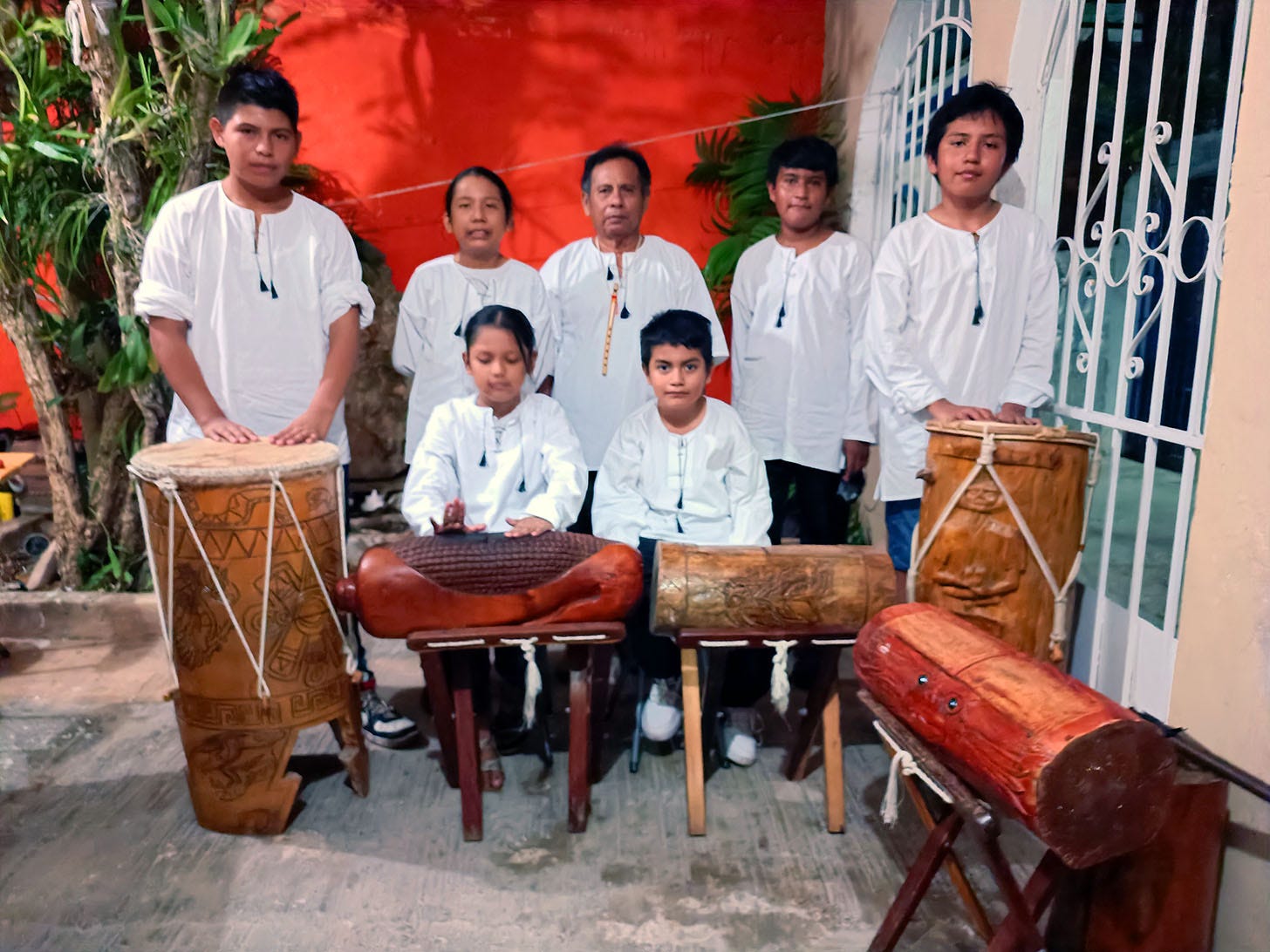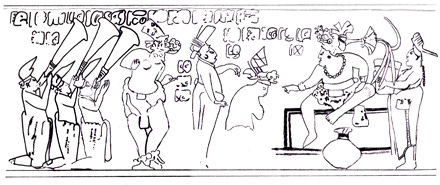Meet an Unique children's Orchestra of Mayan Rhythms, and Discover the Worst Place to Die in Pre-Hispanic Times
Travel with us from your seat anywhere in the world, from the Mayan region to the Aztec region in Mexico.
Section 1: "The people behind of...”
The Pre-Hispanic Music Orchestra "Ahol Pop" (the singer of the people in the Mayan language) of San Francisco de Campeche, and its founder, José Encarnación Saravia Saravia
Para una versión en español de la entrevista pica aquí
For an explanatory video in Spanish about pre-Hispanic Mayan rhythms and instruments, click here
Basic pre-Hispanic rhythm with percussion and the seashell (Video: Mexico Unearthed, 2024)
The small but great orchestra, in the center José Saravia and his boys with the tunkules and huehues (Photo México Unearthed, 2024)
Today, We are very proud to introduce our next cultural hero, the founder of the pre-Hispanic rhythm orchestra "Ahol Pop" (the singer of the people in the Mayan language), born in San Francisco de Campeche and with a degree in social sciences, a master's degree in higher education and a specialty in anthropology.
Contact and information:
Email: josesaraviacu@hotmail.com
The Project and its origin
The Ahol Pop project, "The Singer of the People," emerged in 1997 as a creative idea to show something different in the altar contests held to celebrate the Day of the Dead in Campeche. The idea was to rescue the pre-Hispanic rhythms of the Mayan culture.
Finally, it was formally established in 2006 and has participated in numerous local, national, and international venues, such as music festivals and events at educational institutions such as the Instituto Campechano and the Universidad Autónoma de Campeche, events in Guatemala supporting the communities of that region, and 17 Latin American folk music events.
However, despite promoting pre-Hispanic Mayan roots, the group has yet to receive any support from local or national governments or institutions. The founder and the children's parents cover 100% of all travel expenses and everything the group needs.
With these children, it is the sixth generation of Mayan musicians under the direction of Maestro Saravia, whose classroom is also in his own house with the approval of the neighbors.
He mentions that:
"...the project intends to rescue our culture, not only the Mayan culture but also the music of all indigenous peoples, such as Andean music."
Thus, José Saravia also directs a group of high school students who play Andean music, which he considers part of this continent's original music.
Following to the orchestra director (Photo: Mexico Unearthed, 2024)
The Music of the Mayans
The teacher explained to us that until now, no one knew how pre-Hispanic music sounded, but we used exact replicas based on codices such as the Durán, murals (such as those of Bonampak in the State of Chiapas), and images on Mayan vases (specifically from the Southern Lowlands) that show these instruments.
He also pointed out that, based on these sources, we know that the orchestras of musicians had two fundamental elements that marked the rhythm: the Sacatán and the Tunkul (which in the Nahuatl tradition are called Huehue and Teponaztle).
For example, both decorated percussions were as masterfully crafted as a corn cob or a jaguar. The first was similar to modern congas, and the second, made from hollow trunks played by a percussionist, has no similarity with any modern instrument.
Musicians in Structure 1, room 1, north wall. Bonampak Archaeological Zone, Chiapas; Mexico
Royal Court with musicians in Painting on a ceramic vase from the Kerr Collection, from the Archaeological Zone of Palenque, Chiapas; Mexico
The music, in addition to these two, was complemented with snails, rattles, flutes, scrapers, the shell of the hicotea turtle (Trachemys callirostris) that was hit with deer antlers (which is the grandmother or predecessor of the tunkul), wooden trumpets that require a lot of lung capacity and technique) and clay ocarinas that imitate the roar of the jaguar and the sound of eagles.
The music was sacred and accompanied religious and war rituals. The instruments must always be treated with respect because they were considered gods.
Mayan music was based on two sounds, the ti and the to, as the codices say, and tried to imitate the sounds of nature: the wind, the water, and the earth. Some trumpets imitate the sound of the god Itzamná, whose sound comes from the planet.
"These instruments were so important that during the colonial period, the Spanish ordered them to be burned so that we would forget our culture. Our Mayan culture has not died and is re-emerging thanks to children and young people"
The professor with exact replicas of the Mayan trumpet and the Sacatan drum (Photo: Mexico Unearthed, 2024)
The person behind "Ahol Pop"
"I learned that there is no point in knowing something if it is not to teach it to others"
José Encarnación Saravia Saravia is from Campeche and shared a great truth with us:
"… those of us who study social sciences, the more we study, the more we return to our origin and begin to rescue our culture. People who prepare themselves in the field of social sciences return to their roots while those who study other sciences forget who they are"
"I am truly proud of my origin, I tell everyone, I am proudly a descendant of the Mayans. Of course, I am. Do you know what my son's name is? Hunaxel!"
Hunaxel was the last Mayapán ruler (the ancient great pre-Hispanic capital of northern Yucatán), and it means "the only descendant of heaven."
He points out that Mayan names are not so common and it is not that they are ugly but that we are not used to hearing them.
Proud of his roots (Photo Mexico Unearthed, 2024)
Final Message
As a final message, the professor shares an anecdote with us:
"We participated in a youth singing contest, and the jury said that they play very beautifully but that music is no longer used. We give them scholarships so that they can go study jazz. And the boys simply said: We don't want to learn jazz. What we want is to continue with our culture."
"We have to go back to our own. And going back to our own doesn't necessarily mean going back to wearing loincloths... We are not the barbaric indigenous people that they want us to believe."
He points out that to this day there are people who still ignore that pre-Hispanic cultures have been revalued and are a source of national and international pride. He recounted the case of the parents of a student who was forbidden to continue playing because it is "Indian music." What do you think about this?
He invites us to return to our roots and to feel proud of our ancestors. He thinks it is not right to support jazz and rock but not the music of our ancestors, and he is absolutely right.
—----
I am infinitely grateful to the Maestro and his excellent students for having delighted us with what they know how to do and for having infected us with their enthusiasm and love for the music of Pre-Hispanic Mexico.
We hope these children will spread the pride of having in their blood the blood of the great Mayan civilization and its knowledge. It was a wonderful personal experience to meet them all since the work they do is almost unique and rare to find, which is why they are so valuable.
If you were captivated by this cultural cause and its founder and want to support them in some way, contact them directly to support and/or spread their work and reward their efforts.
Another way to support is by sharing this article so that more people know what they do.
Information and data: José Saravia Cu, Mayo 2024
Foto, video and text edition: Guadalupe Zetina Gutiérrez, July 2024
Section 2: the short reading from the editor's keyboard
(8 minutes of reading)
The City Bathed in Human Blood
If you were not born Mexica, prepare to die in the most luxurious and extravagant capital of a Mesoamerican Empire
Personal didactic material based on the Duran Codex shows the interpretation of the Spanish friars about the sacrifices made on Tenochtitlan (2020)
Before I begin my story, I want to clarify that all the information here is not fiction and is based on historical sources, indigenous codex from the 16th and 17th centuries, and my knowledge and experience as an archaeologist for more than twenty years of trajectory.
I have only summarized the information and added my style of narration. I hope you enjoy it.
Note: Many images in this post are illustrated with Codex (folding books on deer skin leaves or pieces of fiber paper from the amate plant Ficus cotinifolia), and the Spanish conquerors destroyed most of them and rewrite them later, with annotations and their own reinterpretation in Spanish during 16Th and 17th centuries.
Let’s go!
Tenochtitlán, the Great Capital of Mexica (or Aztec) Empire and Human Sacrifice
Imagine that one day, you are at home with your family or working on your land, and suddenly, an armed group arrives to ask you for a large part of your assets or capture one or more members of your family.
These military campaigns to kidnap victims for public sacrifice were called “flowery wars”.
The Aztecs or Mexicas (below, I will explain differences) had control of the roads, the production and distribution of all the goods, and control over all of human life.
Representation of elite Mexica (or Aztec) warriors: eagle and jaguar knights with their weapons in the Durán Codex (Edited material based on Durán Codex of my personal files, 2020)
They took control by military force of most of the Mesoamerican territory: Tlaxcaltecs, Purepecha, Totonacs, Mixtecs, these are some of the names of the subjugated people…and of course, some border territories of the Maya.
However, they could never control the latter due to their political organization of independent states, and the Mayan jungle was too intricate and dangerous to keep under the power of foreigners without the knowledge of this labyrinth.
To read it completely, click here free of charge to the original publication on the Medium platform.
Do you want to contribute to this newsletter or do you want to actively participate in our non-profit Association?. Send a message below
If you want support my free work, Invite me a coffee of US$4.00 to Mexico Unearthed please here!
See you Soon!













What an interesting article, Guadalupe! I enjoyed learning how the maestro from Campeche and others researched to discover what the Maya sounds were like. And so interesting that the murals at Bonampak, along with the codices, gave them direction. Thanks for an enlightening post!